|

|

|
|
ストライダー飛竜
©Capcom 1989
©1994 NEC Avenue. Ltd
Release : 1994-09-22 (¥6000)
ArcadeCDRom² NAPR-1041
Action
|
Strider Hiryū is an action game by NEC Avenue and conversion of Capcom's
classic arcade game of the same name originally released in 1989. In the year 2042, the world is
crumbling under the rule of a heartless dictator named Meio (the 'Grand Master')
and his mysterious army. Six years later, Hiryū (the 'Flying Dragon'), a
A-Class agent from the elite anti-terrorist group called the 'Striders', is given
the mission to reach Meio's hideout, the Third Moon, and to eliminate the evil
dictator. Hiryū's journey begins in Kafazu, a fortress city in Russia,
and his mission eventually takes him to a variety of hostile locations - from frozen Siberia
to the heart of the Amazonian forest or deep inside a space station orbiting around the Earth.
Like all the A Class members of the Striders secret organization, Hiryū is
armed with a lethal plasma-blade called the 'Cypher' that can cleave through obstacles and
enemies in a single blow - and Hiryū is very proficient at it. Additionally, the elite soldier is an
expert in acrobatics and he uses this unerring dexterity for evading enemy attacks or sneaking up
on them. With the help of a special claw, the agile Strider can climb vertical walls or
inclined platforms with incredible ease. Hiryū can also acquire small robotic drones to
help him with his mission - some just stay close to the player and attack enemies, whereas others,
such as the Hawk or the Panther, just kill enemies on the screen. Additionally,
special small containers are scattered throughout the levels and release various power ups items,
such as Life upgrades (increase the player's life bar), Sword upgrades (increase
the range of the Cypher) or temporary invulnerability. This PC Engine
version of Strider Hiryū consists of six stages (as opposed to five in the original
arcade game) as well as exclusive animated cutscenes and an arranged redbook soundtrack.
|
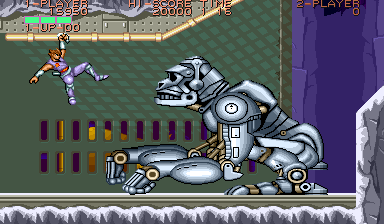 The arcade game Strider Hiryū was originally released in 1989 to great popular acclaim.
Ironically though, and according to Kouichi Yotsui (the original game designer), Strider
didn't sell that well and wasn't a commercial success... but it is today considered as a landmark in
action-platformer history. The game was ported to several home systems - Commodore Amiga (1989),
Commodore 64 (1989), Amstrad CPC (1989), Atari ST (1989), Sinclair ZX 81 (1989),
NES (1989), Sega Megadrive (1990), Sega Master System (1991), Sharp X68000 (1992)
and PC engine Arcade CDRom (1994). The history behind the NES/Famicom version is rather
interesting and closely related to the production of the original arcade game, read on. The 8-bit version
is actually totally different than the arcade and is based instead on a Japanese comic book by
Kadokawa Shoten, and released in 1989. The manga was originally published in 1988 in the monthly
The arcade game Strider Hiryū was originally released in 1989 to great popular acclaim.
Ironically though, and according to Kouichi Yotsui (the original game designer), Strider
didn't sell that well and wasn't a commercial success... but it is today considered as a landmark in
action-platformer history. The game was ported to several home systems - Commodore Amiga (1989),
Commodore 64 (1989), Amstrad CPC (1989), Atari ST (1989), Sinclair ZX 81 (1989),
NES (1989), Sega Megadrive (1990), Sega Master System (1991), Sharp X68000 (1992)
and PC engine Arcade CDRom (1994). The history behind the NES/Famicom version is rather
interesting and closely related to the production of the original arcade game, read on. The 8-bit version
is actually totally different than the arcade and is based instead on a Japanese comic book by
Kadokawa Shoten, and released in 1989. The manga was originally published in 1988 in the monthly
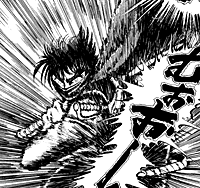 Japanese comic Comic Computique (in six episodes, picture on the left), and was illustrated by Tatsumi Wada
and written by Tetsuo Shiba (artists from the Moto Kikaku manga group). Interestingly,
the comic served as a basis for the arcade game (and the NES/Famicom game) and was created as a
joint venture with Capcom. Kouichi Yotsui even revealed in an interview
that the 'Strider' project counted three products sharing the same title - a comic book, an
arcade game and a Famicom port. Although the first two were officially released, the Japanese
Famicom version designed by Masahiko Kurokawa (who has tragically passed away since)
was announced several times and even featured its own Japanese TV Commercial! But for reasons
unknown, the game was eventually cancelled, and for even more obscure reasons, it was curiously
officially released for the
NES in the United States. As a side note, a couple of
Strider Famicom prototypes have surfaced on online auction sites though, as well as
professionally made reproduction cartridges....
Japanese comic Comic Computique (in six episodes, picture on the left), and was illustrated by Tatsumi Wada
and written by Tetsuo Shiba (artists from the Moto Kikaku manga group). Interestingly,
the comic served as a basis for the arcade game (and the NES/Famicom game) and was created as a
joint venture with Capcom. Kouichi Yotsui even revealed in an interview
that the 'Strider' project counted three products sharing the same title - a comic book, an
arcade game and a Famicom port. Although the first two were officially released, the Japanese
Famicom version designed by Masahiko Kurokawa (who has tragically passed away since)
was announced several times and even featured its own Japanese TV Commercial! But for reasons
unknown, the game was eventually cancelled, and for even more obscure reasons, it was curiously
officially released for the
NES in the United States. As a side note, a couple of
Strider Famicom prototypes have surfaced on online auction sites though, as well as
professionally made reproduction cartridges....
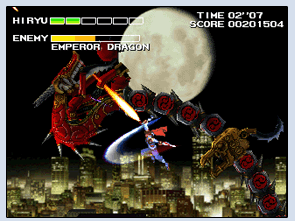 Another Strider game followed after the arcade game but it was not endorsed by Capcom
and it was never released in Japan - Strider Returns was published by US Gold and
released for the Sega Megadrive (1990) and Sega Game Gear (1994). The game is really
mediocre and not worth mentioning in details. But a true sequel does exist! The excellent arcade game
Strider 2 was released by Capcom in 1999 (picture on the left). The game does what its predecessor did so well,
and does it better, faster and adds some more features of its own. The game was only ported to the
Sony Playstation in 2000, and this conversion also included the original Strider arcade
game (as well as an hidden stage and unlockable characters).
Another Strider game followed after the arcade game but it was not endorsed by Capcom
and it was never released in Japan - Strider Returns was published by US Gold and
released for the Sega Megadrive (1990) and Sega Game Gear (1994). The game is really
mediocre and not worth mentioning in details. But a true sequel does exist! The excellent arcade game
Strider 2 was released by Capcom in 1999 (picture on the left). The game does what its predecessor did so well,
and does it better, faster and adds some more features of its own. The game was only ported to the
Sony Playstation in 2000, and this conversion also included the original Strider arcade
game (as well as an hidden stage and unlockable characters).
|
Strider was designed by Kouichi Yotsui (also known as the pseudo name 'lsuke').
He joined Capcom in 1986 and worked with other prestigious video game designers such as
Tokuro Fujiwara (Maikaimura, Bionic Commando, Mega Man 2) before designing
Strider, his first project as a game designer. He however left the company soon after the release
of Strider, and joined other ex-Capcom colleagues at Takeru (also known under
their publishing name 'Sur Dé Wave'). There, he designed the text-driven adventure game
Nostalgia 1907 (Sharp X68000, Sega CD, NEC PC-9801 and
FM Towns) - but the game was a commercial failure, and he soon left the Japanese developer,
feeling partially responsible for the company financial issues that followed, and its demise in 1994
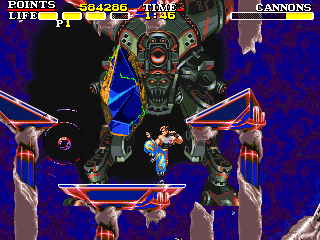 (see Cocoron for more information about Takeru). But what all of this has to do with
Strider you shall ask? Well, things are about to become more relevant - Kouichi Yotsui
then moved to Mitchell Corporation where he designed the fighting game Chatan Yarakū Shanku
(aka The Karate Tournament) and the puzzle game Lady Killer. But, most importantly, he also
designed the obscure arcade action platformer Cannon Dancer (aka Osman) in 1996 (picture on the right) - and
this game is as close to a sequel (or spiritual sequel) to Strider as you can possibly get.
Kouichi Yotsui himself even admitted in a interview that he considers Cannon Dancer
to be its own Strider 2! The game shares many similarities with the original
Strider - it features a terrific pace and the level design is impressive with varied
locations and bosses at each corner.
(see Cocoron for more information about Takeru). But what all of this has to do with
Strider you shall ask? Well, things are about to become more relevant - Kouichi Yotsui
then moved to Mitchell Corporation where he designed the fighting game Chatan Yarakū Shanku
(aka The Karate Tournament) and the puzzle game Lady Killer. But, most importantly, he also
designed the obscure arcade action platformer Cannon Dancer (aka Osman) in 1996 (picture on the right) - and
this game is as close to a sequel (or spiritual sequel) to Strider as you can possibly get.
Kouichi Yotsui himself even admitted in a interview that he considers Cannon Dancer
to be its own Strider 2! The game shares many similarities with the original
Strider - it features a terrific pace and the level design is impressive with varied
locations and bosses at each corner.
|
There has been a lot of drama surrounding the release of this PC Engine port of
Strider Hyriū. You may have noticed that it was released in 1994 - five years after
the original arcade game, and four years after the Sega Megadrive version. So what happened?
It seems that original work began on a Super Grafx HuCard version in 1990 - but, apparently,
the failure of the system forced NEC Avenue to make a CDRom version instead (it seems
that the choice of the Arcade Card came later). Although the incredible delay is explainable,
various pictures appeared in Japanese magazines around 1990 arguably "showing" images of
the game in action. And indeed, the images do show differences with the original arcade game
(they could be pictures taken from an arcade beta version though). In any case, this was
enough to start a rumor mill among PC Engine fans, and this subject
remains a topic of controversy, still to this day. But we should take all of this with a grain of
salt - there are a number of urban legends that have become part of the Strider
SuperGrafx story, and I won't mention them here. But something is sure - to this day,
nothing rules out the existence of a potential SuperGrafx prototype.
Interestingly, this PC Engine port was made by the Japanese developer Dice Creative.
Their website states that the company was created in response to
a request for third party outsourcing by Satoru Iwata (Manager of Development
of HAL Laboratory at the time and
now president of Nintendo). They first released the gambling game
Vegas Stakes/Las Vegas Dream (Super Famicom, 1993) and
Strider for the PC Engine followed in 1994.
This is rather strange if you take into consideration that Dice only
developed "low-profile" games for Hal Laboratory, such as Adventure of Lolo (GameBoy, 1994),
Itoi Shigesato no Bass No.1 (Super Famicom, 1997) or
SimCity 64 (Nintendo 64, 1999), and Strider was
the only PC Engine game they ever made... How did they end up inheriting
NEC Avenue's Strider project?
However, all of this partly explains why Strider looks under part compared
to other NEC Avenue games...
|
This PC Engine port is quite faithful to the original arcade game. But, NEC Avenue
(maybe in a way to apologize for the game being delayed) added an exclusive second stage (a desert camp level),
as well as new animated cutscenes filling out the story in even more detail and a CD quality remixed soundtrack.
However, the game lost the original parallax scrolling and the stage layout is slightly different in places.
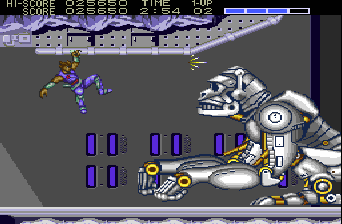 There is something else I would like to add about this PC Engine Arcade CDRom version. The letterbox 4:3
aspect ratio has always bothered me - the arcade game has this terrific wide-screen view of the action, which
is lost in this conversion. Or is it? A close inspection reveals that the game is actually displayed in wide-screen
anamorphic picture format. The screen has been horizontally squeezed so it could be displayed using the native
PC Engine resolution - but when shown on a wide-screen TV, the screen can be stretched and the game can
finally reveal its true intentions! (picture on the right).
There is something else I would like to add about this PC Engine Arcade CDRom version. The letterbox 4:3
aspect ratio has always bothered me - the arcade game has this terrific wide-screen view of the action, which
is lost in this conversion. Or is it? A close inspection reveals that the game is actually displayed in wide-screen
anamorphic picture format. The screen has been horizontally squeezed so it could be displayed using the native
PC Engine resolution - but when shown on a wide-screen TV, the screen can be stretched and the game can
finally reveal its true intentions! (picture on the right).
|
Game Staff (Copied from the end credits) :
CAST
Hiryō/Shiozawa Kaneto
Tōma Yumi
Hori Yukitoshi
Ikeda Shūichi
Yada Kōji
Matsui Maaji
Grand Master/Toitani Kōji
Narration/Kayumi Iemasa
|
|
STAFF
Game Part
Program
Imagawa Toyohiro
Takahashi Gorō
Map Graphics
Ishii Sencho
Saitō Akihiro
Sugino Gen
Nakamura Nobumasa
Horiguchi Masao
Visual Demo Part
Program
Watanabe Mamoru
|
|
Character Design
& Animate
Inano Yoshinobu
Graphics
Aoki Yūko
Ishii Sencho
Ōtsu Chiaki
Saitō Akihiro
Sugino Gen
Maruyama Seiji
Music
K.M. Brothers
Original Game Made by
Capcom
|
|
Produce
Saitō Akihiro
Direction
Ōno Satoshi
Executive producer
Tabeta Toshio
Manufactured
Dice Co.Ltd
Copyright
CAPCOM
NEC Avenue,Ltd
End
|
|
O
M
A
K
E
|
|
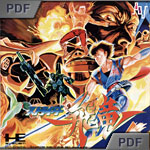

|
|
|
Click on picture to enlarge |
|
|
|
LK

|
|
Add your Pov here !
|
P
O
V
s
|
|
Not many arcade games before Strider Hiryū managed to immerse the player into a
world that felt both cohesive and genuinely exiting. The attention to detail was
superb and the levels were particularly imaginative - the game just sprinted from
one memorable moment to the next. Yes, as you can tell, Strider was one of my favorite arcade
game as a child. So what about this PC Engine conversion? Well, the game is
very disappointing - after brilliant ports such as Forgotten Worlds and
Daimakaimura, NEC Avenue didn't really deliver the goods with this
one (and they were late at that!). The exclusive and added content is
awesome - the extra level is average but adds a nice touch to the game, the
remixed soundtrack is great (mostly) and the cutscenes add depth to the original
story. However, the animation is not really as smooth as anticipated, and the
game is plagued with slowdowns and sprite flickerings. I also can't really put
my finger on it, but the controls feel less responsive overall. Because of all
the added content, I still recommend any Strider fan picking this
conversion up (the game has now become a rather pricey
collector's item though...)
|
|
|
|